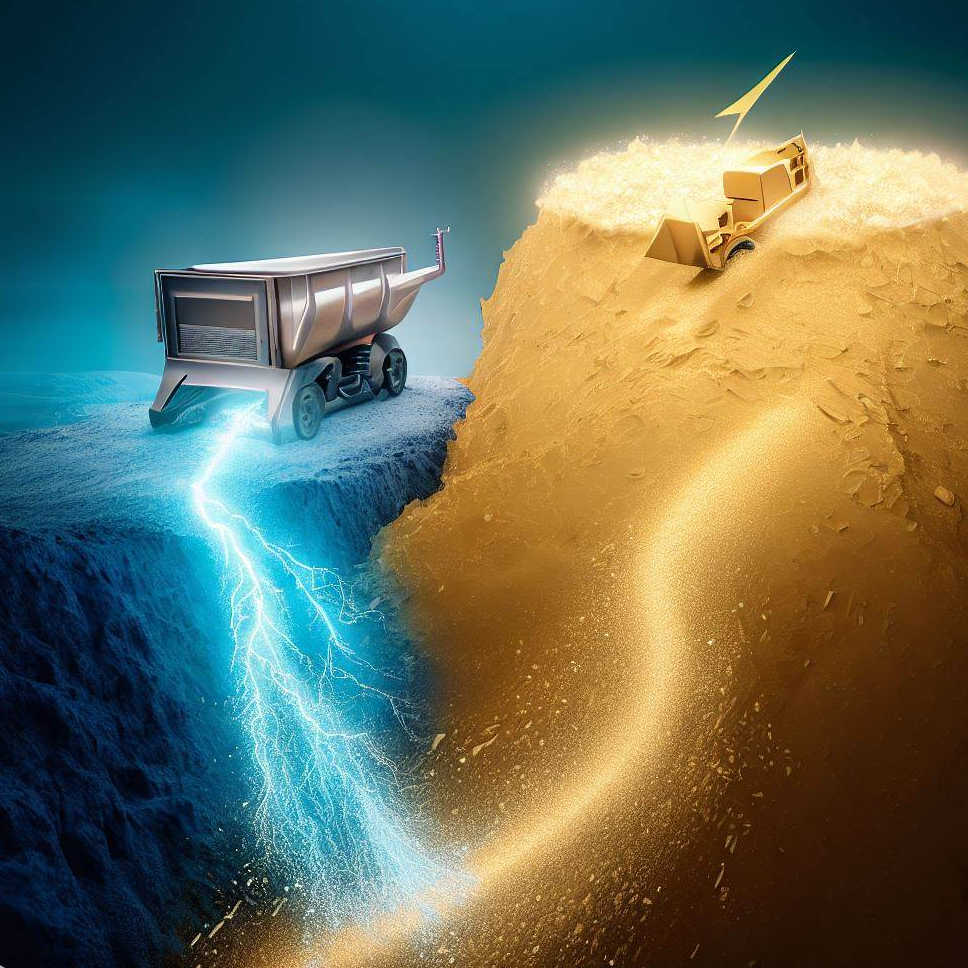In the ever-evolving landscape of technology and renewable energy, the demand for batteries has skyrocketed. Batteries have become an integral part of our lives, powering our smartphones, electric vehicles (EVs), and even storing renewable energy generated from solar and wind farms. As a result, the global race to secure a stable supply of battery materials, particularly lithium, has transformed into a modern-day "battery rush."
Historically, gold rushes have captivated the world's attention, with individuals flocking to regions in search of the precious metal. However, as the world becomes increasingly reliant on battery-powered devices and green energy solutions, lithium has emerged as the new sought-after resource.
We have compiled a timeline highlighting the key events and milestones in the transition from the Gold Rush to the modern-day Lithium Rush in the battery industry:
-
1848-1855
Gold Rush Era -
1848
Discovery of gold at Sutter's Mill in California triggers the California Gold Rush. -
1849-1855
Massive influx of prospectors from around the world seeking fortune in gold mining. -
1991
Commercialization of Lithium-ion Batteries
Sony Corporation introduces the first commercial lithium-ion battery, revolutionizing portable electronic devices.
-
Late 1990s-early 2000s
Electric Vehicle Development
Automakers begin research and development of electric vehicles (EVs), laying the groundwork for increased battery demand.
-
2003
Global Lithium-ion Battery Production Surpasses One Billion Units
The production of lithium-ion batteries reaches a significant milestone, driven by the increasing popularity of portable electronics.
-
Late 2000s
EV Market Expansion
Tesla Motors introduces the Tesla Roadster, the first high-performance electric sports car, marking a significant milestone in EV market expansion.
-
2010
Lithium Demand for EV Batteries Begins to Surge
The increasing adoption of electric vehicles, particularly Tesla's Model S, starts driving up the demand for lithium-ion batteries.
-
2015
Paris Agreement and Growing Emphasis on Renewable Energy
The Paris Agreement is signed, highlighting the importance of transitioning to renewable energy sources and stimulating the demand for energy storage solutions.
-
2016
Lithium Prices Soar
Lithium prices experience a significant spike due to the rising demand for lithium-ion batteries, particularly for EVs.
-
Present Day
Modern-Day Battery Rush
Ongoing global race to secure lithium and other critical battery materials to meet the growing demand for lithium-ion batteries.
Rapid expansion of lithium mining operations worldwide, including in Australia, Chile, China, and Argentina.
Advancements in battery technology, such as solid-state batteries and recycling initiatives, to enhance efficiency and sustainability.
Continued growth of the electric vehicle market and renewable energy sector driving the need for more batteries and battery materials.
| Year | Event/Statistic |
|---|---|
| 1848-1855 | California Gold Rush: Massive influx of prospectors seeking gold. |
| 1991 | Commercialization of lithium-ion batteries by Sony Corporation. |
| Late 1990s-early 2000s | Research and development of electric vehicles (EVs) gains momentum. |
| 2003 | Global lithium-ion battery production surpasses one billion units. |
| Late 2000s | Tesla Motors introduces the Tesla Roadster, a high-performance electric sports car. |
| 2010 | Surge in lithium demand for EV batteries begins. |
| 2015 | Signing of the Paris Agreement, emphasizing the transition to renewable energy. |
| 2016 | Significant spike in lithium prices due to rising demand. |
| Present Day | Ongoing global race to secure lithium and critical battery materials. |
The timeline showcases the shift from the historic Gold Rush era to the present-day Lithium Rush, reflecting the evolving demand and focus on battery technology and its crucial role in powering our modern world.
What is Lithium? What are its uses?
Lithium, a light and highly reactive metal, is a key component of lithium-ion batteries, the most common type of rechargeable batteries used today. These batteries offer high energy density, longer life cycles, and the ability to be recharged multiple times, making them ideal for a wide range of applications.
Lithium is a chemical element that belongs to the alkali metal group on the periodic table. It is the lightest metal and highly reactive. Here is some information about lithium and its uses:
Lithium's Uses:
Lithium-ion Batteries: The primary use of lithium is in lithium-ion batteries. These batteries are widely used in portable electronic devices such as smartphones, laptops, tablets, and smartwatches. They also power electric vehicles (EVs) and provide energy storage solutions for renewable energy sources like solar and wind.
Electric Vehicles: Lithium-ion batteries play a crucial role in the electric vehicle industry. The high energy density and rechargeable nature of lithium-ion batteries make them ideal for powering EVs, offering longer driving ranges and shorter charging times.
Renewable Energy Storage: Lithium-ion batteries are essential for storing energy generated from renewable sources like solar and wind. They enable the efficient utilization of renewable energy by storing excess energy during times of low demand and releasing it when needed, reducing reliance on fossil fuels and improving grid stability.
Aerospace and Defense: Lithium batteries are used in aerospace applications, including spacecraft, satellites, and military equipment. The lightweight and high-energy capacity of lithium batteries make them desirable for these applications, where weight and performance are critical factors.
Medical Devices: Lithium batteries are commonly used in various medical devices, such as pacemakers, defibrillators, and hearing aids. These devices require reliable and long-lasting power sources, and lithium batteries provide the necessary performance and longevity.
Industrial Applications: Lithium is used in lubricants, greases, and heat-resistant glass products. It also finds applications in the production of ceramics, glass, and aluminum.
Pharmaceuticals: Lithium compounds are used in the treatment of certain mental health conditions, including bipolar disorder. Lithium carbonate and lithium citrate are prescribed medications for mood stabilization and reducing the frequency and severity of manic episodes.
Alloys and Ceramics: Lithium is alloyed with other metals to enhance their properties, such as increasing strength, reducing density, or improving heat resistance. Lithium is also used in ceramics, particularly in high-temperature applications.
The Modern-Day Significance of Lithium:
- Lithium's diverse range of applications and its pivotal role in the battery industry have made it a highly sought-after resource in the modern world. The increasing demand for lithium is driving exploration, mining, and technological advancements to ensure a stable supply and promote sustainable and responsible resource management.
- The rise of electric vehicles, in particular, has been a significant driver in the surge for lithium. With governments and consumers alike pushing for greener transportation options, EVs have gained immense popularity. However, the lithium demand for EV batteries is substantial. A typical EV battery pack can contain several thousand lithium-ion cells, requiring thousands of kilograms of lithium. This surge in demand has created a sense of urgency to secure lithium supplies, leading to what many refer to as the "battery rush."
- Australia, known for its rich mineral resources, has been a major player in the lithium market. The Greenbushes lithium mine in Western Australia is the world's largest hard-rock lithium mine, accounting for a significant portion of global lithium production. Other countries like Chile, China, and Argentina also hold significant lithium reserves and have become key players in the battery rush.
- The race to secure lithium supplies has not been without challenges. The extraction of lithium is a complex process that involves mining and processing lithium-containing ores. There are concerns about the environmental impact of lithium mining, especially in fragile ecosystems like salt flats and water resources in lithium-rich regions. Balancing the growing demand for lithium with sustainable and responsible mining practices remains a crucial consideration for the industry.
- To meet the escalating lithium demand, efforts are underway to diversify lithium sources and develop innovative battery technologies. Lithium recycling and extraction from unconventional sources such as geothermal brines and seawater are being explored to ensure a more sustainable supply chain. Additionally, researchers are investigating alternative battery chemistries that reduce or eliminate the need for lithium altogether, such as solid-state batteries or lithium-sulfur batteries.
- The battery rush extends beyond lithium, with other critical battery materials also in high demand. Cobalt, nickel, and graphite are essential components of lithium-ion batteries and face their own supply challenges. Cobalt, in particular, has drawn attention due to ethical concerns surrounding its mining practices in certain regions. Efforts are underway to reduce the dependence on these materials or find alternative substitutes to ensure a more sustainable and ethical battery industry.
- The modern-day battery rush has not only transformed the energy and transportation sectors but has also sparked a wave of investment and innovation. Countries and companies are actively investing in battery manufacturing facilities, research and development, and infrastructure to support the growing demand for batteries. Governments are implementing policies and incentives to accelerate the adoption of electric vehicles and renewable energy, driving the need for more batteries and consequently, more battery materials.
- As the world transitions towards a low-carbon future, the battery rush will continue to shape the global economy and resource landscape. Balancing the demand for battery materials with sustainability, ethical mining practices, and responsible resource management will be paramount. The race is not just for the next big mineral discovery but for a greener and more sustainable future.
- In the quest for a greener and more sustainable future, the battery rush has triggered a wave of technological advancements. Researchers and scientists are continuously working towards developing more efficient, longer-lasting, and environmentally friendly battery technologies. Solid-state batteries, for example, hold promise for higher energy density, improved safety, and reduced reliance on rare and expensive materials. These batteries use solid electrolytes instead of liquid electrolytes, which offer advantages such as higher energy density, longer cycle life, and increased resistance to overheating.
- Moreover, the battery rush has catalyzed the development of energy storage systems that can store and distribute renewable energy effectively. As the world strives to transition from fossil fuels to renewable energy sources, such as solar and wind, the ability to store this intermittent energy becomes crucial. Large-scale battery storage systems are being deployed to stabilize the electrical grid, provide backup power during peak demand, and enable a higher penetration of renewable energy.
- In addition to technological advancements, the battery rush has significant economic implications. The demand for battery materials has created new economic opportunities and reshaped global trade dynamics. Countries with abundant lithium, cobalt, and other critical battery materials have found themselves in positions of strategic importance. They have the potential to become major players in the global battery supply chain and attract investments in mining, processing, and battery manufacturing.
- To capitalize on this opportunity, governments and companies are establishing partnerships and strategic alliances to secure a stable supply of battery materials. International collaborations for resource exploration, research, and development are on the rise. Additionally, initiatives are being undertaken to establish transparent and responsible supply chains, ensuring that the mining and processing of battery materials adhere to stringent environmental and social standards.
- The battery rush has also ignited fierce competition among automakers, technology giants, and start-ups in the electric vehicle market. Established automotive companies are accelerating their plans to electrify their vehicle fleets, while new entrants are emerging with innovative electric vehicle designs. The race to develop better and more affordable electric vehicles has spurred advancements in battery technology, charging infrastructure, and vehicle efficiency.
- Furthermore, the battery rush has the potential to reshape geopolitical dynamics. Countries with significant lithium and battery material reserves could gain geopolitical influence as the demand for these materials continues to soar. This has prompted governments to develop strategic plans and policies to secure their domestic supply chains and reduce dependence on imports.
- However, challenges remain on the path to a sustainable and responsible battery industry. The environmental impact of lithium mining, the ethical concerns associated with cobalt mining, and the disposal of used batteries pose significant challenges. It is crucial to develop comprehensive recycling infrastructure and circular economy models to minimize the environmental footprint of batteries and maximize resource recovery.
conclusion: the modern-day battery rush, driven by the demand for lithium and other critical battery materials, has revolutionized the energy and transportation sectors. As the world embraces renewable energy and electric vehicles, the need for advanced batteries will continue to grow. This rush has sparked technological innovation, economic opportunities, and geopolitical considerations. The key to a successful battery industry lies in balancing this rapid development with sustainable resource management, responsible mining practices, and the development of environmentally friendly battery technologies. The battery rush represents not only a race for resources but also a race towards a greener and more sustainable future.
Discover More
Most Viewed
Christmas is a season of joy, love, and traditions. And what better way to get into the holiday spirit than through timeless carols? These musical gems have been bringing people together for generations. Here’s our ranked list of the Top 10 Christmas Caro…
Read More

















